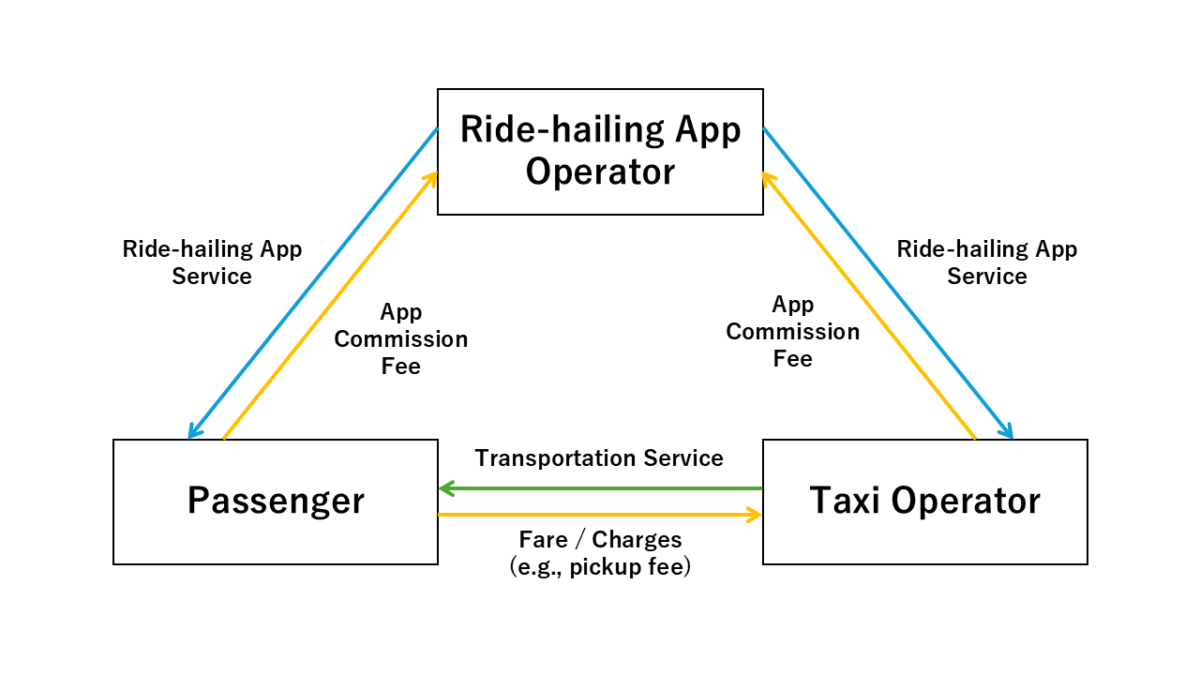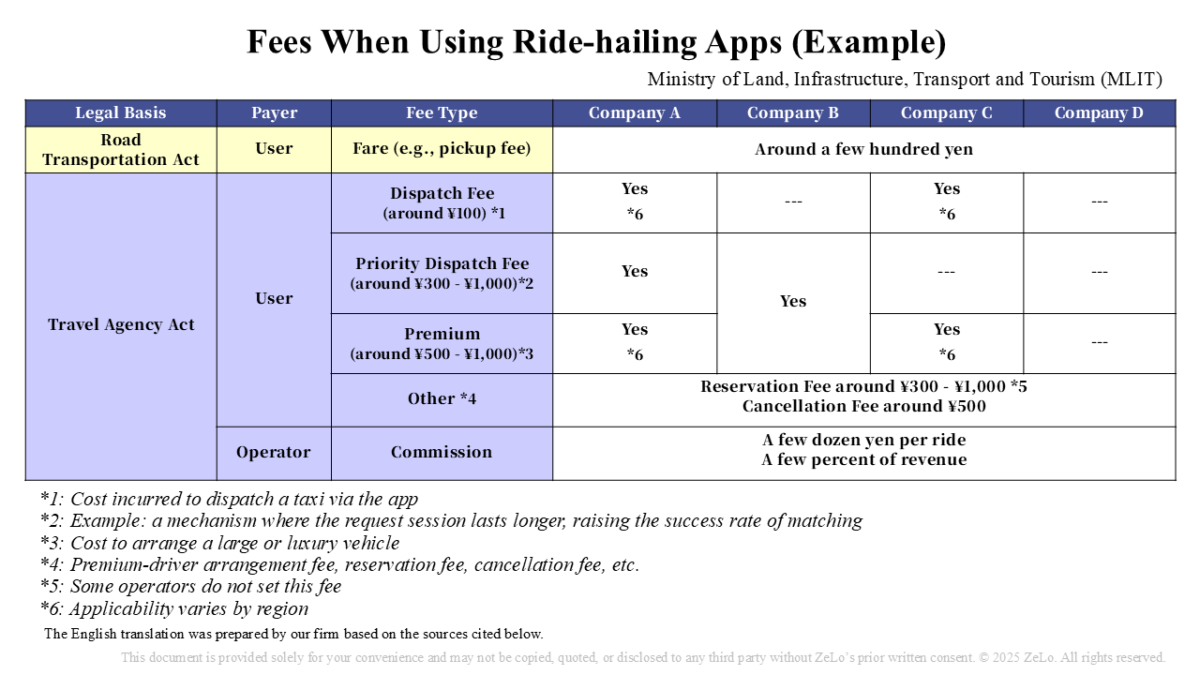[2025 Latest Trends] How Will Regulation of Ride-Hailing Apps Change? A Lawyer Explains Key Forthcoming Issues, with a Focus on Fee Regulation

Attorney admitted in Japan
Keita Mashita
![[2025 Latest Trends] How Will Regulation of Ride-Hailing Apps Change? A Lawyer Explains Key Forthcoming Issues, with a Focus on Fee Regulation](https://zelojapan.com/wp/wp-content/uploads/2025/05/250514_img-top-608x336.jpg)
On 6 May 2025 the Ministry of Land, Infrastructure, Transport and Tourism (“MLIT”) was reported to have decided in principle to regulate the dispatch fees charged when a taxi is booked and ridden via a ride-hailing app [1] (the “News Report”). In addition, on 23 April 2025 the Japan Fair Trade Commission (“JFTC”) released the “Market Study on Ride-Hailing Applications in Japan” [2] (the “JFTC Report”), setting out the competition-law and policy considerations relevant to the ride-hailing business. Based on these latest developments, a lawyer with experience drafting rules for bus- and taxi-related passenger transport while seconded to the Passenger Division of MLIT’s Road Transport Bureau explains the likely direction of regulation, centered on fee regulation, of ride-hailing apps.
![[2025 Latest Trends] How Will Regulation of Ride-Hailing Apps Change? A Lawyer Explains Key Forthcoming Issues, with a Focus on Fee Regulation](https://zelojapan.com/wp/wp-content/uploads/2025/05/250514_img-top-1920x1008.jpg)
Graduated from Nagoya University (LL.B, 2016), passed Japan Bar Exam (Registered in 2018). Experience at Mori Hamada & Matsumoto (2019-2023), seconded to Road Transport Bureau of the Ministry of Land, Infrastructure, Transport and Tourism (Passenger Transport Division and Accident Compensation Policy Office) (2021-2023), and joined ZeLo (2023-). Main practice areas include M&A, startup law, regulations on automobiles, mobility and transportation, dispute resolution, and public affairs.
目次
A ride-hailing app matches passengers (the demand side) with taxis[3] (the supply side) using digital technology. A simplified illustration of the service and money flows appears below.

Two statutes are relevant: the “Road Transport Act” and the “Travel Agency Act”.
Under Article 12, paragraph 2 of the Travel Agency Act and Article 21 of its Enforcement Regulations, the fees a travel agent collects from travelers (other than for package tours) must be set at fixed percentages, fixed amounts, or other methods appropriate to the type and content of the contract and must be clearly disclosed to travelers. There is no requirement for governmental approval, nor any statutory caps or floors on such fees.
Accordingly, provided the fees are clearly disclosed to passengers, dispatch fees may presently be set at the operator’s discretion.
Because app operators are free to set dispatch fees, they employ a wide variety of fee structures. In addition to ordinary dispatch, operators may charge extra for advance bookings, for specifying vehicle types or driver attributes, or for priority dispatch during periods of congestion.

Concerning this point, while the JFTC Report organizes the perspectives under the Antimonopoly Act and competition policy on the ride-hailing-app business[5], it points out, as set out below, that among dispatch fees, surcharges collected in times of demand tightening such as priority dispatch fees ought to be paid to taxi operators.
(Transaction between ride-hailing-app operators and passengers)
(4) Priority-dispatch service
Some ride-hailing-app operators offer passengers a priority-dispatch service. As stated in III-5 above, certain taxi operators have expressed the view that—even if they dispatch taxis in response to passengers’ use of such priority-dispatch services during congested periods—the burden on drivers is heavy, while they receive no corresponding benefit.
One reason passengers pay an additional fee to use the priority-dispatch service is thought to be that, in periods when the supply of taxis is small, passenger-side mobility demand cannot be met. In this regard, even if passengers pay the surcharge to the ride-hailing-app operator, it does not lead to an increase in taxi supply; by contrast, were the surcharge to become income for taxi operators, it is considered that this would lead to an increase in taxi supply and, in turn, to the fulfilment of passengers’ mobility demand.
With respect to taxi fares, MLIT is currently examining a fare-and-charge system that responds to high-demand time periods. From the standpoint of securing the basis of the competitive environment and ensuring passenger convenience, it is desirable that the additional amount passengers pay in times of supply-demand tightening be paid to taxi operators as taxi fares, etc., since this would increase taxi supply by improving taxi operators’ income.Looking at trends on the supply side, the number of registered taxi drivers has been on a recovery trajectory since April of Reiwa 5 (2023), increasing by more than 10,000 by January of Reiwa 7 (2025). In addition, in order to meet passenger demand under tight taxi supply, the Japan-style rideshare introduced in March of Reiwa 6 (2024) has undergone successive upgrades expanding its scope. Furthermore, most recently, consideration is under way to expand the entities eligible to operate Japan-style rideshare from taxi operators to include bus and railway operators as well. It remains important to secure an environment in which passenger mobility demand can be adequately met under conditions of taxi supply shortage.
(The English translation was prepared by our firm based on the sources cited below.
Source: Japan Fair Trade Commission (April 2025), “Market Study on Ride-Hailing Applications in Japan,” https://www.jftc.go.jp/houdou/pressrelease/2025/apr/250423ridehailing_04.pdf pp 36-37 underlining in the original quotation.)
This is the only point at which the JFTC ventures an affirmative recommendation “from the viewpoint of competition and passenger convenience.” The wording also appears calibrated to accord with MLIT’s transport policy—and with the new fare-and-fee regime likely to be introduced under the Road Transport Act—suggesting the JFTC’s view may influence that forthcoming regime.
According to the News Report, MLIT intends to regulate dispatch fees, possibly by converting them to an approval-based system. The motives cited include passenger confusion between dispatch fees and fares/pick-up charges, and a desire to pre-empt excessive fee hikes.
Discussion of such regulation is underway in:
The Autonomous Driving WG’s suggested direction (extract below) substantially accords with this article’s analysis.
Future Direction (Draft) Regarding Taxi Fares and Charges
Ministry of Land, Infrastructure, Transport and Tourism (MLIT)
- At present, fees charged by ride-hailing apps are governed by the Travel Agency Act and are outside the fare-and-charge regulations of the Road Transportation Act.
- Given the role of taxis as public transportation, should we consider bringing under the Road Transportation Act’s fare regulations those app fees that users find hard to distinguish from statutory taxi fares/charges (e.g., pickup fees)?
- Conversely, where users lack sufficient information about the varying services that taxi operators offer such as special vehicles or top-rated drivers, it may be appropriate to regard as “travel products,” and thus outside the scope of Road Transportation Act regulation, situations in which an app operator with broad knowledge of those services matches them to user needs in a one-stop manner.
--> Future Direction (Draft)
In view of the fact that ride-hailing apps will be indispensable for autonomous taxis and that app-based dispatches are expected to increase, especially in urban areas, it is necessary to clarify the relationship between the taxi fare/charge regime including autonomous vehicles and ride-hailing-app fees, and to address the issue institutionally.
(The English translation was prepared by our firm based on the sources cited below.
Source: Transport Policy Council, Land Transport Subcommittee, Automobile Committee, 4th Autonomous-Driving Working Group, Ministry of Land, Infrastructure, Transport and Tourism, Logistics and Automobile Bureau, Passenger Division (17 March 2025), “[Material 4] Proposal on Regulatory Framework for Platforms Involved in Taxi Dispatch,”https://www.mlit.go.jp/policy/shingikai/content/001882994.pdf excerpt from p. 5)
Based on the foregoing, the points to note concerning regulation of the ride-hailing-app business may be summarized as the following five items:
At present, the dispatch fee in ride-hailing-app business is remuneration for a “hand-arranged tour” service under the Travel Agency Act and is outside the fare/charge regulation of the Road Transport Act.
To make it subject to the approval system under the Road Transport Act (Art. 9-3, para. 1) would, in all likelihood, require action at the statutory level such as amending the Road Transport Act itself or enacting a special law.
Where statutory-level action is needed, Diet deliberation is required, and the procedures and time involved are far greater than in the case of subordinate legislation. Hence, a concrete regulatory regime for dispatch fees will probably not be in place until 2026 at the earliest.
“Dispatch fees” comprise two kinds: those collected from passengers and those collected from taxi operators.
According to the direction shown by the Autonomous Driving WG, what is being newly considered for regulation appears to be “fees that users find hard to distinguish from fares/charges (pick-up fees) under the Road Transport Act” (emphasis added), suggesting that passenger-side dispatch fees are the primary target.
However, dispatch fees collected from taxi operators can affect their operating costs and, by extension, the service supply structure and level. The JFTC Report likewise records opinions on the burden of dispatch/payment fees borne by taxi operators. Accordingly, it cannot be ruled out that some form of rule will be debated not only for passenger-side fees but also for operator-side fees.
Besides ordinary dispatch, the ride-hailing-app business offers value-added services such as advance booking, vehicle-type or driver-attribute specification, and priority dispatch during congestion, and additional fees may be charged for these.
The Autonomous Driving WG states that, where individual users lack sufficient information about which taxi operators can provide special vehicles or superior drivers, it may be appropriate to regard an app operator that has broad knowledge of such information and matches services one-stop to user needs as providing a travel product per se, and thus outside the scope of the Road Transport Act (emphasis added). Accordingly, fees for arranging special vehicles or drivers other than priority dispatch may be distinguished from dispatch fees and continue to be treated as consideration for a hand-arranged tour under the Travel Agency Act, that is, outside the Road Transport Act.
How broadly the concept of “dispatch fee” will be drawn therefore becomes a key issue.
The Autonomous Driving WG direction suggests that priority-dispatch fees are highly likely to become a regulatory target.
As noted, the JFTC Report points out that surcharges in times of demand tightening should be paid to taxi operators; attention therefore focuses on the content of any regulation.
In the “Study Group on Diversification of Taxi and Japan-Style Rideshare Fares and Charges,” dynamic pricing is being discussed as a fare/charge system for high-demand periods. Given the JFTC’s observation, it is highly probable that surcharges for demand peaks will be treated not as priority-dispatch fees but as peak fares/charges under dynamic pricing, designed so that the additional amount is paid to taxi operators.
The Autonomous Driving WG states that, because ride-hailing apps will be indispensable for autonomous taxis and such app-based arrangements will gradually increase especially in urban areas, it is necessary to organize the relationship between the taxi fare/charge system—including autonomous operation—and the fees charged by ride-hailing apps, and to respond institutionally (emphasis added).
With the full-scale introduction of autonomous taxis, the very structure of transport-service provision may change. For example, in autonomous taxis, the method of operation management changes, and the cost structure—such as labor costs forming the basis for fare calculation—may also change.
While the appropriate system for fares/charges in the autonomous-taxi era must be considered separately, an important task will be how to position dispatch fees within that new fare/charge framework.
As productivity gains from ride-hailing and the commercialization of autonomous taxis progress, platform operators will wield ever-greater influence. The JFTC Report and MLIT’s moves aim to secure adequate supply to meet mobility demand and to build a regime adaptable to the autonomous era. Continued developments bear close watching.
ZeLo excels not only in traditional corporate practice such as litigation and dispute resolution, but also in cutting-edge areas like Web3 and AI and in supporting novel business models. In the automotive and mobility sector we provide specialized advice from lawyers deeply versed in relevant regulation, including alumni of MLIT’s Road Transport Bureau.
We tailor our advice to each client’s business model and needs—please feel free to contact us (https://zelojapan.com/en/contact).
This article is an English translation of the original Japanese article. Please click here for the Japanese original.
[1]Yomiuri Shimbun Online, “MLIT to Regulate Ride-Hailing App Fees, Considering Approval System to Curb Taxi Fare Hikes” (last accessed 13 May 2025).
[2]Japan Fair Trade Commission, “Market Study on Ride-Hailing Applications in Japan” (23 Apr 2025) (last accessed 13 May 2025).
[3] In addition to taxis, some apps match vehicles engaged in Japan-style ridesharing (private-car use) or public ridesharing (paid transport by private cars). For simplicity, this article assumes apps that dispatch taxis.
[4] Some app operators also offer package tours as principal under the Travel Agency Act.
[5] The JFTC Report also discusses, inter alia, the antitrust risks of discriminatory treatment in matching criteria or unilateral changes to such criteria; those points are beyond the scope of this article.
[6]https://www.mlit.go.jp/jidosha/jidosha_tk3_000123.html
[7]https://www.mlit.go.jp/policy/shingikai/s201_jidouunntenn01.html
The information provided in this article does not, and is not intended to, constitute legal advice and is for general informational purposes only. Readers of this article should contact an attorney to obtain advice with respect to any particular legal matter.
![[2025 Latest Trends] How Will Regulation of Ride-Hailing Apps Change? A Lawyer Explains Key Forthcoming Issues, with a Focus on Fee Regulation](https://zelojapan.com/wp/wp-content/uploads/2021/08/img_zls_cta_left-1-1440x640.jpg)
![[2025 Latest Trends] How Will Regulation of Ride-Hailing Apps Change? A Lawyer Explains Key Forthcoming Issues, with a Focus on Fee Regulation](https://zelojapan.com/wp/wp-content/uploads/2021/08/img_zls_cta_right-1-1440x640.jpg)